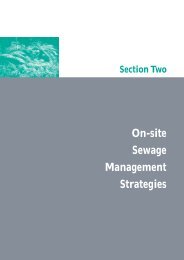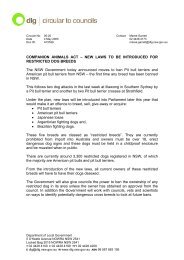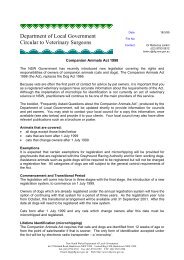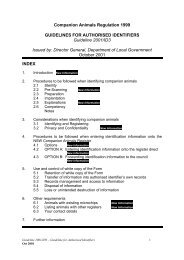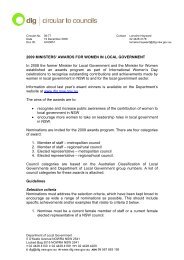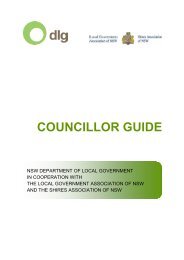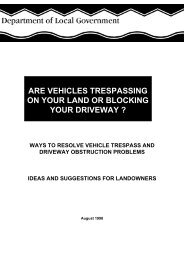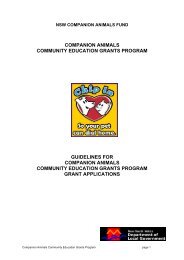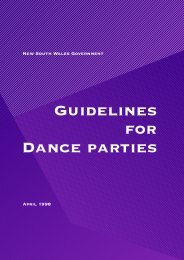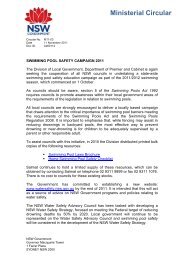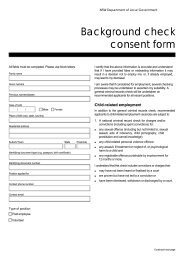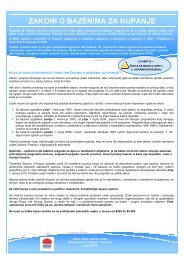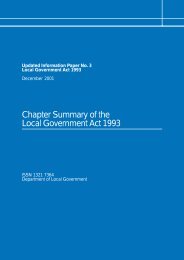Integrated Planning and Reporting Manual - Division of Local ...
Integrated Planning and Reporting Manual - Division of Local ...
Integrated Planning and Reporting Manual - Division of Local ...
You also want an ePaper? Increase the reach of your titles
YUMPU automatically turns print PDFs into web optimized ePapers that Google loves.
6. THE ANNUAL REPORT<br />
6.5 <strong>Reporting</strong> on the State <strong>of</strong> the Environment<br />
The State <strong>of</strong> the Environment report is now due once every four years. It is to be included in the<br />
Annual Report in the year <strong>of</strong> the ordinary election. It must report on the environmental objectives in<br />
the Community Strategic Plan.<br />
The legislative requirements have been amended to provide councils with the flexibility to prepare<br />
their State <strong>of</strong> the Environment Report in a way that enables councils to focus their resources on<br />
monitoring <strong>and</strong> reporting on environment issues that are <strong>of</strong> concern to their community <strong>and</strong> where<br />
council may influence their management.<br />
Councils should ensure that their State <strong>of</strong> the Environment <strong>Reporting</strong> is integrated with the<br />
Community Strategic Plan. The information in the State <strong>of</strong> the Environment Report should be used<br />
to inform Council’s preparation <strong>of</strong> the Community Strategic Plan <strong>and</strong> continue to inform the required<br />
reviews <strong>of</strong> the Community Strategic Plan.<br />
Councils are also strongly encouraged to develop their State <strong>of</strong> the Environment report in<br />
partnership with other councils in their region <strong>and</strong> Catchment Management Authorities, as<br />
environmental monitoring <strong>and</strong> reporting is more useful when done at a regional <strong>and</strong>/or catchment<br />
scale. State <strong>of</strong> the Environment <strong>Reporting</strong> at a regional <strong>and</strong>/or catchment scale provides<br />
opportunities to draw from a wider range <strong>of</strong> data, to form Memor<strong>and</strong>a <strong>of</strong> Underst<strong>and</strong>ing or datasharing<br />
arrangements, <strong>and</strong> to develop shared arrangements for environmental monitoring with State<br />
agencies <strong>and</strong> other organisations to achieve efficiencies <strong>and</strong> lead to more consistent environmental<br />
monitoring <strong>and</strong> reporting across NSW.<br />
Regional State <strong>of</strong> the Environment reporting models have been established by regional groups <strong>of</strong><br />
councils. An example <strong>of</strong> this is the Northern Sydney Regional Organisation <strong>of</strong> Councils (NSROC)<br />
State <strong>of</strong> the Environment reporting. A catchment based example is the Namoi Regional State <strong>of</strong> the<br />
Environment report which was produced for 2007-2008.<br />
The NSROC model, which also includes a Regional Sustainability Plan, is an example <strong>of</strong> how<br />
councils can work effectively on a regional basis to take advantage <strong>of</strong> sharing ideas on sustainability<br />
reporting, environmental management practices <strong>and</strong> other innovations to establish stronger regional<br />
links <strong>and</strong> improve environmental outcomes. It is also an example <strong>of</strong> how the State <strong>of</strong> the<br />
Environment report is utilised to inform future planning for the area.<br />
Councils are required to report on environmental indicators that they have established. This enables<br />
them to identify if they have achieved the environmental objectives in their Community Strategic<br />
Plan. Councils can use previous State <strong>of</strong> the Environment Reports to enable trends to be monitored<br />
over time, but it is important that councils critically review their current environment reporting system<br />
to ensure that it is integrated <strong>and</strong> relevant to Council’s long-term environmental objectives, <strong>and</strong><br />
enables informed planning for the future.<br />
Councils may choose to continue to apply the Pressure-State-Response (PSR) model to report on<br />
the environmental indicators that they establish (this model is explained in detail in the<br />
Environmental Guidelines: State <strong>of</strong> the Environment <strong>Reporting</strong> by <strong>Local</strong> Government, DLG, 2000).<br />
Councils must consult with their community, <strong>and</strong> in particular, environmental groups in their area<br />
when preparing the report. Community involvement <strong>and</strong> monitoring <strong>of</strong> the environment can provide<br />
councils with useful environmental information to assist the development <strong>of</strong> the report. It also<br />
provides an opportunity for councils to educate the community <strong>and</strong> raise environmental awareness.<br />
Councils are required to complete a comprehensive State <strong>of</strong> the Environment report with their<br />
2008/09 annual report. The first State <strong>of</strong> the Environment report under the new planning <strong>and</strong><br />
reporting framework covering 2009 - 2012 is due on 30 November 2012.<br />
<strong>Planning</strong> & <strong>Reporting</strong> <strong>Manual</strong> Page 112 <strong>of</strong> 115



